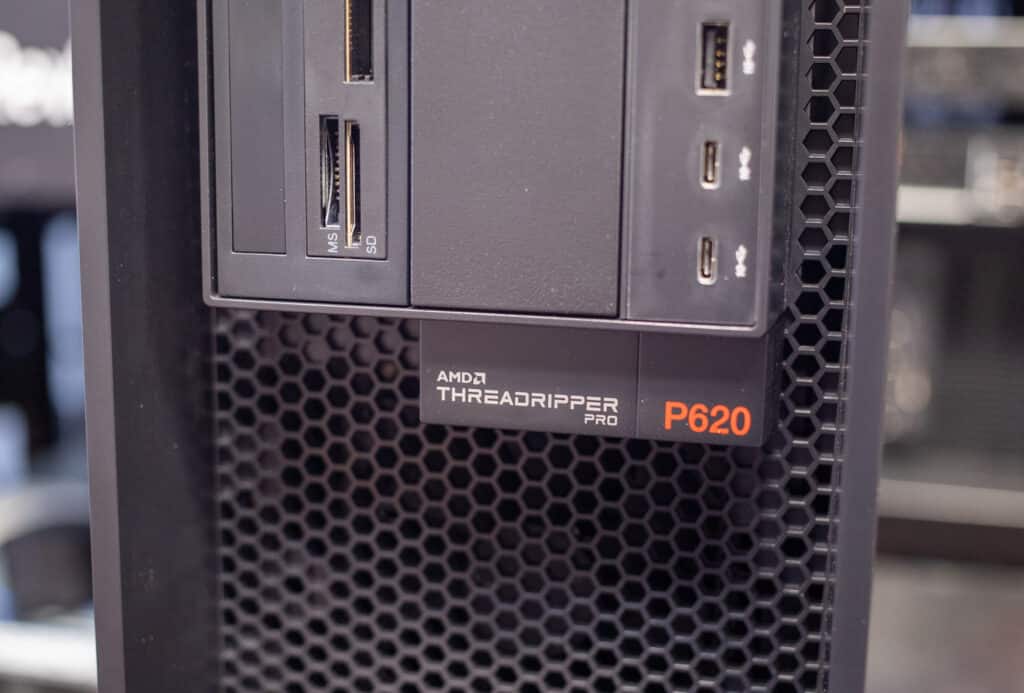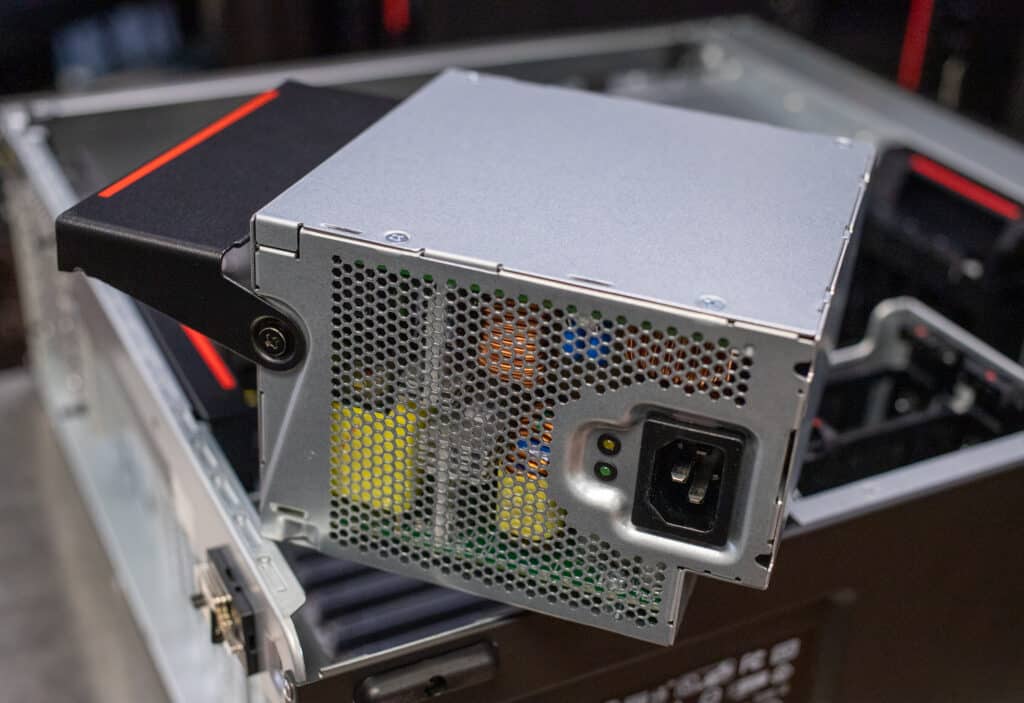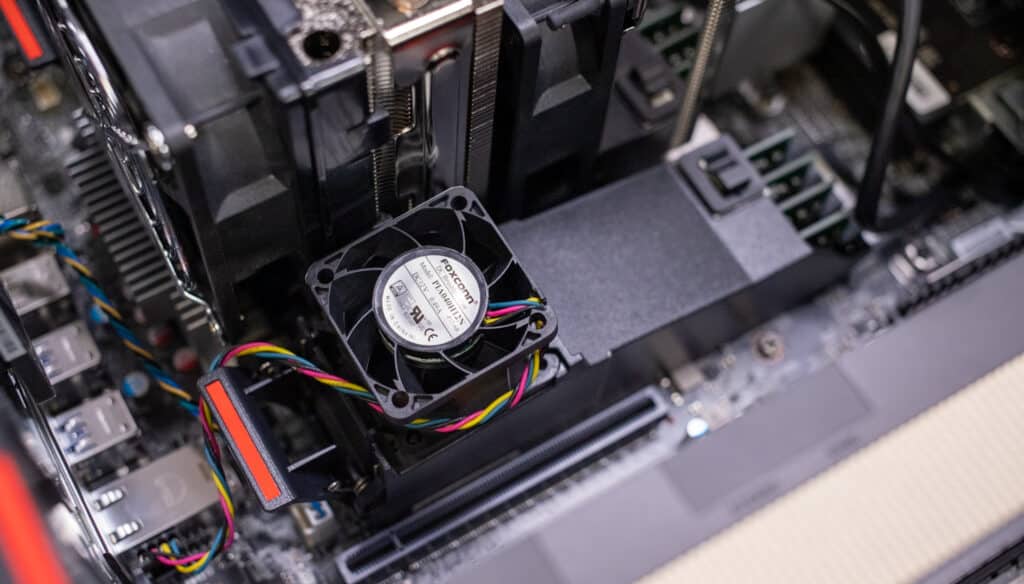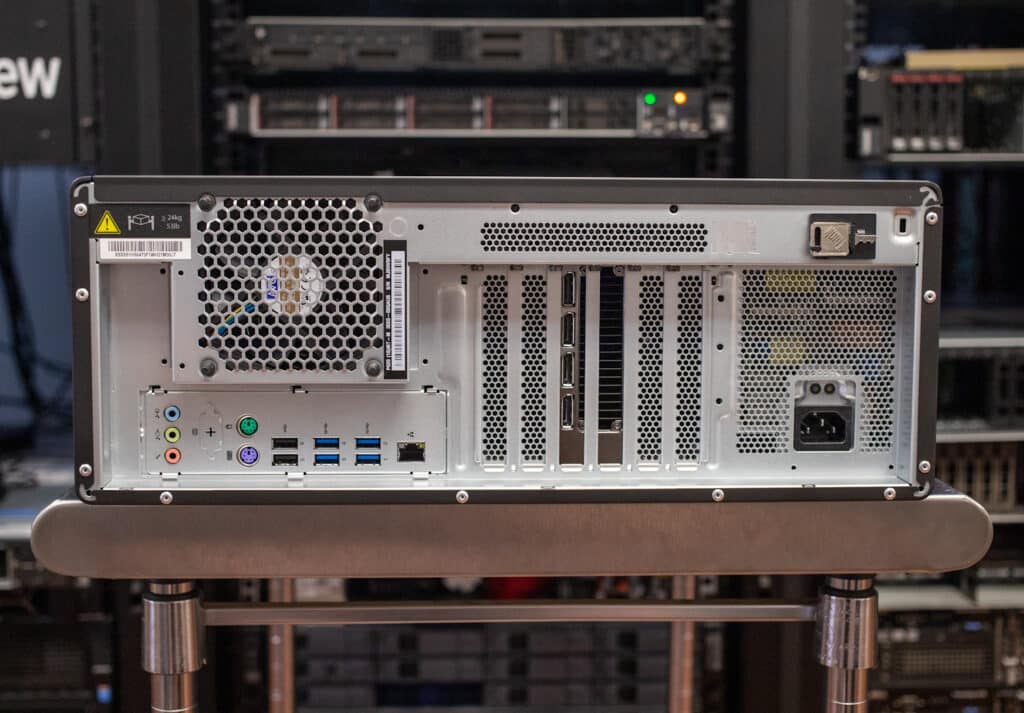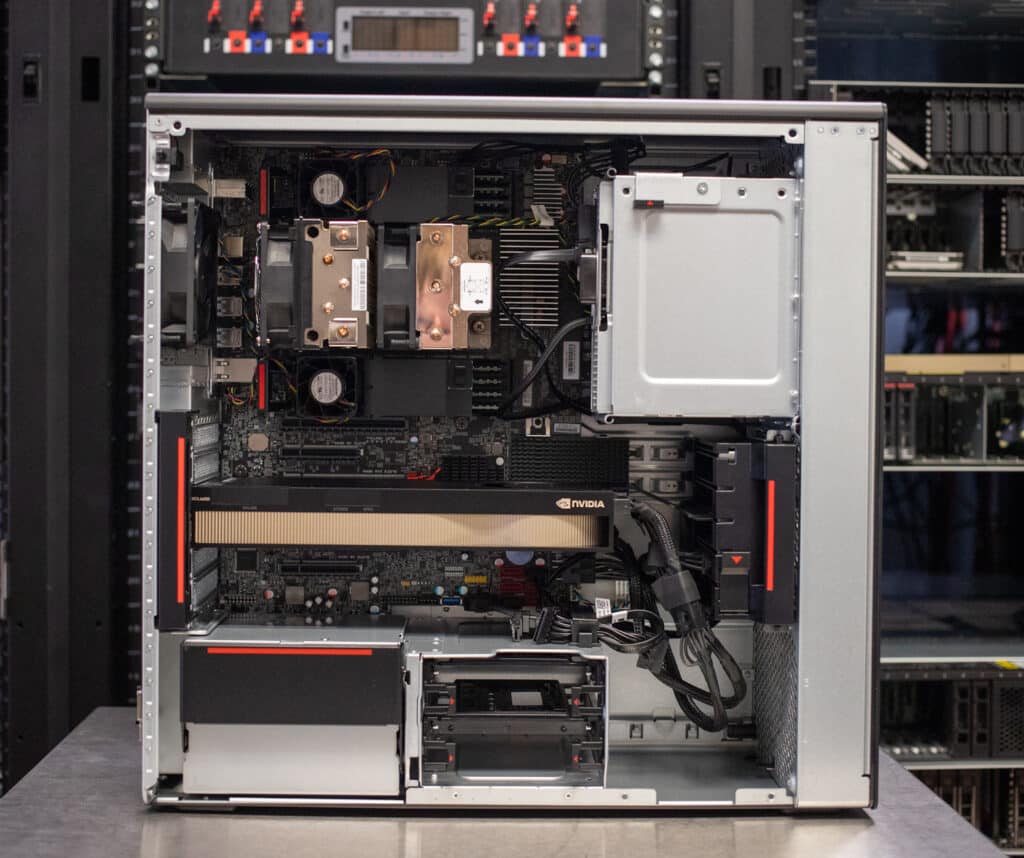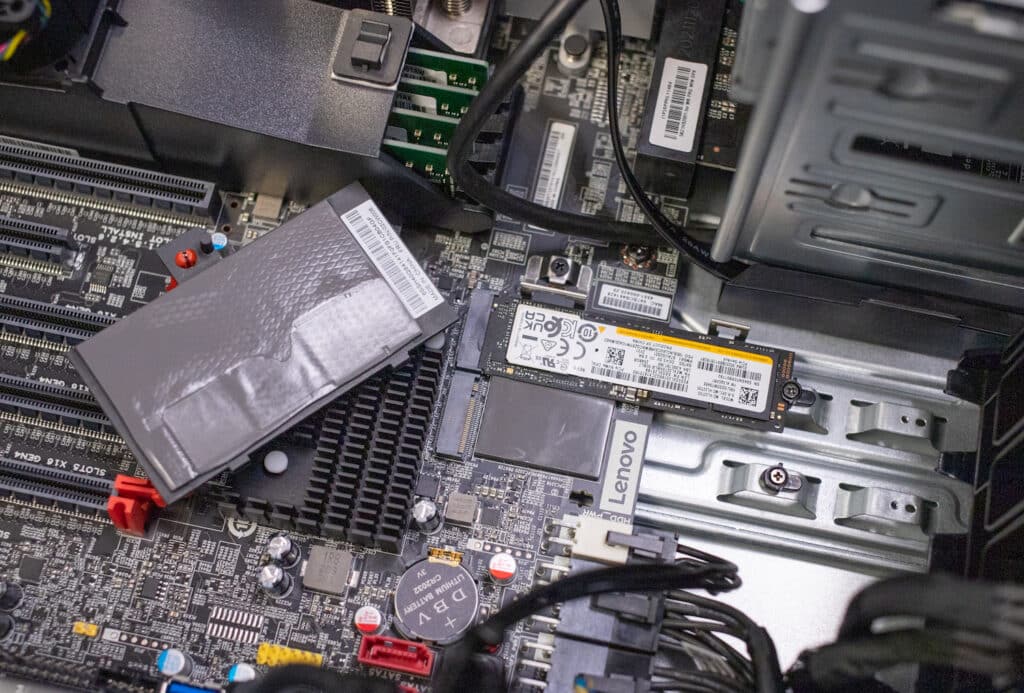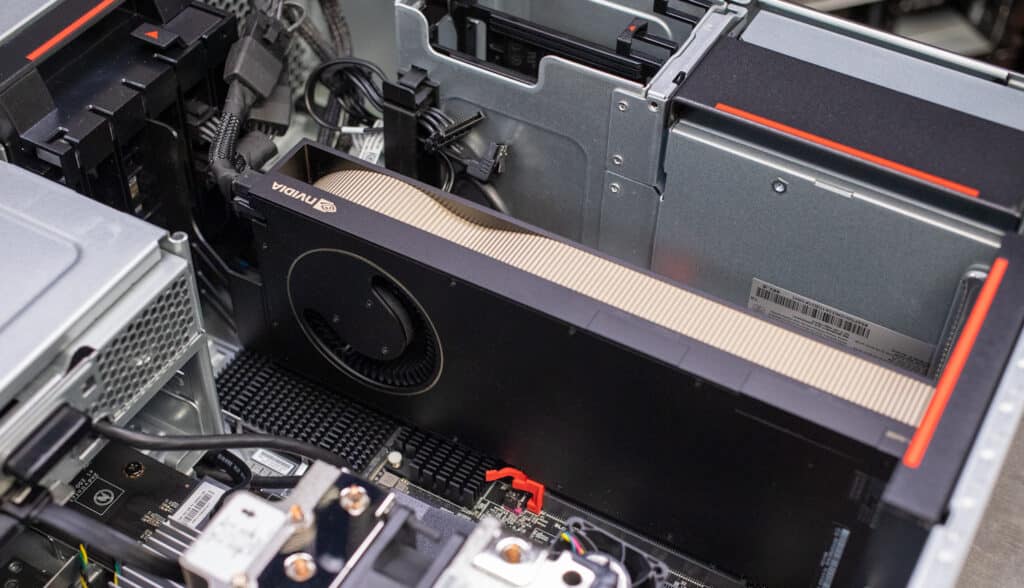Lenovo has unleashed the newest version of ThinkStation P620, which was the industry’s first Threadripper Pro workstation when it was initially released back in 2021. When we first looked at the ThinkStation P620, we saw huge performance boosts to the workstation sphere (via a single socket no less), making it a must-buy for high-end professionals. Now the system has been updated with support for the AMD Ryzen Threadripper PRO 5995WX processor and support for two NVIDIA RTX A6000 graphics cards.
Lenovo has unleashed the newest version of ThinkStation P620, which was the industry’s first Threadripper Pro workstation when it was initially released back in 2021. When we first looked at the ThinkStation P620, we saw huge performance boosts to the workstation sphere (via a single socket no less), making it a must-buy for high-end professionals. Now the system has been updated with support for the AMD Ryzen Threadripper PRO 5995WX processor and support for two NVIDIA RTX A6000 graphics cards.
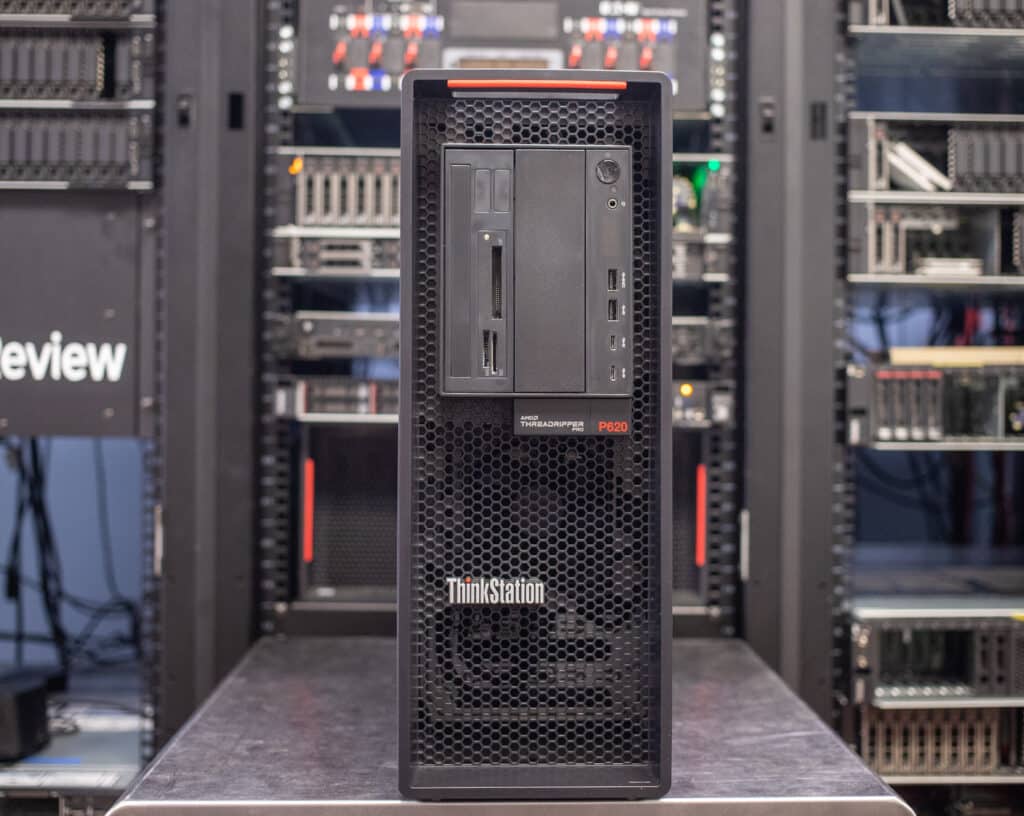
Lenovo ThinkStation P620 Improvements Over Previous Model
The updated P620 is now equipped with the AMD Ryzen Threadripper PRO 5000 WX-Series of desktop processors, which are powered by Zen 3 architecture and feature end-to-end design enhancements, improved energy efficiency, and reduced latencies compared to the previous generation. This means more flexible execution resources, significantly more load/store bandwidth, higher clock speeds, and a streamlined front-end for more threads in flight.
The P620 was already an impressive desktop workstation when we initially reviewed it in early 2021, so the addition of AMD’s new generation of CPUs will certainly help it further outperform its competition. And while there are significant advances in performance with the “Zen 3” architecture, power consumption and TDP remain the same.
The following table is a comparison between the clock speed of two generations of CPUs used inside the older and new P620:
| Lenovo ThinkStation P620 models (previous-gen) | Lenovo ThinkStation P620 models (new CPU) |
| AMD Ryzen Threadripper Pro 3945WX (4.00 GHz, up to 4.30 GHz Max Boost, 12 Cores, 24 Threads, 64 MB Cache | AMD Ryzen Threadripper Pro 5945WX (4.1 GHz, up to 4.5 GHz, 12 Cores, 24 Threads, 64 MB Cache) |
| AMD Ryzen Threadripper Pro 3955WX Processor (3.90 GHz, up to 4.30 GHz Max Boost, 16 Cores, 32 Threads, 64 MB Cache) | AMD Ryzen Threadripper Pro 5955WX (4.0 GHz, up to 4.5 GHz, 16 Cores, 32 Threads, 64 MB Cache) |
| AMD Ryzen Threadripper Pro 3975WX Processor (3.50 GHz, up to 4.20 GHz Max Boost, 32 Cores, 64 Threads, 128 MB Cache) | *New* AMD Ryzen Threadripper Pro 5965WX (3.8 GHz, up to 4.5 GHz, 24 Cores, 48 Threads, 128 MB Cache) |
| AMD Ryzen Threadripper Pro 3995WX Processor (2.70 GHz, up to 4.20 GHz Max Boost, 64 Cores, 128 Threads, 256 MB Cache) | AMD Ryzen Threadripper Pro 5975WX (3.6 GHz, up to 4.5 GHz, 32 Cores, 64 Threads, 128 MB Cache) |
| AMD Ryzen Threadripper Pro 5995WX (2.7 GHz, up to 4.5 GHz, 64 Cores, 128 Threads, 256 MB Cache) |
Lenovo ThinkStation P620 Features
For memory, the total amount of 3200MHz ECC RDIMM that can be added is a healthy 1TB (via 8 DDR4 DIMM slots). It should be noted AMD does not yet support DDR5 in this processor class.
Users can add populate five 3.5-inch bays with the ability to add up to eleven M.2 SSDs (on board: up to 4TB each, M.2 to PCIe adapter: up to 2TB each). Lenovo’s configurator for storage is a little weird, you can only select 4TB HDDs for instance. The system should be just fine with larger HDDs or SSDs if you so choose. Like the DDR being a half-step behind, there’s no Gen5 storage support in this system either.
Another big component that makes the P620 a power contender is the support for the newest professional GPUs available. Users can add up to two NVIDIA RTX A6000 48GB GPUs, which feature 10,752 CUDA processing cores and 84 next-generation RT cores for top-class performance in both real-time ray-tracing and professional final frame ray-tracing output. Users also have a range of other GPU options ranging from entry-level cards to higher-end RTX GPUs. Internal cabling for the GPUs is in place and pretty tidy.
The ThreadRipper Pro Series also features various layers of security via Lenovo’s ThinkShield and Lenovo’s Self-Healing BIOS. In addition, the P620 has dedicated hardware built into the architecture itself. This includes AMD Memory Guard, which grants full memory encryption; and AMD Secure Processor; which validates code before it’s executed to help ensure data/application integrity.
Other specifications of note include the six PCIe Gen4 expansion slots (two x8, four x16) and 1000W Platinum Fixed power supply.
For connectivity, the P620 features four USB 3.2 ports on the front (two of which are USB-C and USB-A), and the usual headphone/microphone audio jack on the front. At the rear are six more USB ports (2x USB 2.0 legacy ports, and four USB 3.2 Gen 2 USB-A ports). This is the same configuration as the previous model. Also on the back panel is one Ethernet port (10GbE RJ-45, Marvell AQtion AQN-107), one line-in (3.5mm), one line-out (3.5mm), and one microphone (3.5mm).
If you’re looking to compare the P620 to other similar systems, options are limited. The only other mainstream Threadripper Pro system is the Supermicro SuperWorkstation 5014A-TT. This is a 64-core, 3995WX-based system that supports up to 2TB of ECC DDR4-3200 RAM, 6x PCIe Gen4 expansion slots, 2000-watt PS/2 multi-output, and up to four double-wide GPUs.
Lenovo offers a 3-year premium support service, which includes things like call center troubleshooting (24x7x365), warranty claims for both parts and labor, OEM software support, and others.
Lenovo ThinkStation P620 Specifications
| Components | |
| Processor |
|
| Processor Sockets | 1x Socket SP3 |
| Discrete Graphics | Up to 2x NVIDIA RTX A6000 48GB |
| Chipset | AMD WRX80 |
| Memory | 8x 16GB RDIMM DDR4-3200 ECC |
| Memory Slots | 8 DDR4 DIMM slots, 8 channels capable |
| Max Memory | Up to 1TB (8x 128GB DDR4-3200 RDIMMs) |
| M.2 SSD RAID Controller | Integrated NVMe controller |
| M.2 SSD Drive | 1x 2TB SSD M.2 2280 PCIe 4.0 NVMe Opal |
| HDD Controller | Integrated SATA controller |
| SATA/SAS Drive | None |
| Storage Support | Up to 5x 3.5″ SATA HDD + 11x M.2 SSD • 3.5″ HDD up to 4TB each • Onboard M.2 SSD up to 4TB each • M.2 SSD by M.2 to PCIe adapter up to 2TB |
| Optical | None |
| Audio Chip | High Definition (HD) Audio, Realtek ALC4050H codec |
| Power Supply | 1000W Platinum Fixed |
| Design | |
| Keyboard | USB Traditional Keyboard, Black, English |
| Mouse | USB Calliope Mouse |
| Expansion Slots |
|
| M.2 Slots | Up to 11x M.2 SSD:
|
| Bays |
|
| Flex Bays | 1x flex bay, supports one of the following:
|
| Dimensions (WxDxH) | 165 x 460 x 446 mm (6.5 x 18.1 x 17.6 inches, with feet) |
| Weight | 24 kg (52.91 lbs, maximum configuration) |
| Connectivity | |
| Onboard Ethernet | Marvell AQtion AQN-107, 1x 10GbE RJ-45 |
| WLAN + Bluetooth | None |
| Card Reader | 15-in-1 Card Reader |
| Front Ports |
|
| Rear Ports |
|
| Security and privacy | |
| Security Chip | Discrete TPM 2.0, TCG certified |
| Physical Locks |
|
| Chassis Intrusion Switch | Lock Kit with Common Key |
| Chassis Intrusion Switch | Chassis intrusion switch |
| BIOS Security |
|
| Manageability | |
| System Management | AMD PRO |
| Diagnostic | Front 4-Digit Diagnostic LED |
| Service | |
| Base Warranty | 3-year, Onsite |
| Included Upgrade | 3-Year Premier Support Upgrade from 3-Year Onsite |
| Certifications | |
| Green Certifications |
|
| Software | |
| Operating System | Windows 11 Pro 64, English |
| Bundled Software | None |
| Operating Environment | |
| Temperature |
|
| Altitude |
|
| Humidity |
|
Lenovo ThinkStation P620 Design and Build
The updated P620 is a full tower workstation, though at 6.5 x 18.1 x 17.6 inches (HWD), it comes in a little more compact than others of this form factor (for example, the Supermicro SuperWorkstation 5014A-TT measures 21.06 x 8.74 x 22.56 inches). Nonetheless, the P620 features the usual dark grey, black (with red highlights) design, with front real estate mainly taken up by ventilation.
The front panel features two USB-A 3.2 Gen 2 ports (one of which is always on / fast charge), two USB-C 3.2 Gen 2 ports, and a headphone combo jack.
Turning the workstation around to the back panel reveals dual legacy USB 2.0 ports, 4x USB-A 3.2 Gen 2 ports, two PS/2 ports (for legacy keyboard/mouse), one 10GbE RJ-45 Ethernet port, and line-in/line-out/microphone (3.5mm) ports. The rest of the rear panel is taken up by the fans, PCIe expansion slots and the PSU.
Taking off the side cover was simple (just use the tab and pull down). Once removed, you can see all the core components and easily access them.
The P620 features a thermal design highlighted by its removable fans located inside the chassis. Lenovo and AMD partnered to create a custom-designed heat sink, which will help users get the best possible (consistent) performance out of their workstations during heavy workloads.
Here, you will see the dual onboard M.2 PCIe connectors. More Gen 4 M.2 NVMe drives can be added via PCIe Gen4 adaptors.
Like all models from Lenovo’s P-series workstations, the P620 features a completely modular design that is highlighted by red “touchpoints” that indicate where a user should place their hand to easily remove and add components. This is a great feature from Lenovo, making upgrading and removing components a seamless process. These red touchpoints also mean that the specific component does not need any tools for it to be removed. The only components that actually do need a screwdriver are the CPU heat sinks.
Not only that, the P620 leverages a handle design, which makes each component slide out easily when you need to replace anything. It also uses a tray design that allows two different drives in a single tray.
Lenovo ThinkStation P620 Performance
The updated Lenovo ThinkStation P620 we’re testing is equipped as follows:
- Windows 10 Pro
- AMD Ryzen Threadripper PRO 5995WX (64C / 128T, 2.7 / 4.5GHz, 32MB L2 / 256MB L3)
- 1TB (8x 128GB DDR4-3200 RDIMMs)
- 1x 2TB SSD M.2 2280 PCIe 4.0 NVMe Opal
- Nvidia RTX A6000 (48GB GDDR6 ECC)
This is a higher-end configuration with the fastest available CPU and GPU for this workstation, while the workstation is outfitted with a maximum of 1TB. This ThinkStation P620 is also fairly easy to upgrade as your needs grow.
We will be comparing the updated ThinkStation P620 to the following systems:
SuperMicro SuperWorkstation 5014A-TT
- Windows 10 Pro
- AMD Threadripper Pro 3995WX (64-core)
- 256GB DDR4-3200 ECC 8-channel RAM (8x 32GB)
- 1TB PCIe 4.0 SSD (Samsung PM981)
- NVIDIA RTX A6000 (48GB GDDR6 ECC)
Lenovo ThinkStation P620 (last gen)
- AMD Threadripper Pro 3995WX (64-core)
- 64GB of RAM DDR4-3200 ECC 8-channel RAM
- 1TB PCIe 4.0 SSD
- NVIDIA RTX A6000 (48GB GDDR6 ECC)
We will also be comparing to our Intel Core i9-12900K (Alder Lake) test rig in some of our tests:
- Intel Core i9-12900K CPU (slightly undervolted)
- Asus ROG Strix Z690-E Gaming WiFi motherboard
- Microsoft Windows 11
- 32GB of Kingston Fury DDR5-5200 RAM (2x 16GB)
- Seagate FireCuda 530 2TB SSD
- NVIDIA RTX A6000 (48GB GDDR6 ECC)
SPECviewperf 2020
SPECviewperf 2020 is the worldwide standard for measuring graphics performance of professional applications under the OpenGL and Direct X application programming interfaces. The viewsets (or benchmarks) represent graphics content and behavior from actual applications, without having to install the applications themselves. The newest version of this benchmark went through major updates late last year, including new viewsets taken from traces of the latest versions of 3ds Max, Catia, Maya, and Solidworks applications. In addition, they added support within all viewsets for both 2K and 4K resolution displays. Our tests were run with a windowed resolution of 3800×2120.
Here, the Lenovo workstation performed better than both its predecessor and the Supermicro tower (though not by too much) while falling slightly behind the Intel 12900L test rig in Crea and Energy areas. This indicates the updated components helped further optimize the A6000 GPU; however, performance was pretty similar across the board.
| SPECviewperf 2020 (Higher is better) | ||||
| Viewsets | Updated Lenovo ThinkStation P620 (Nvidia RTX A6000) | Supermicro AS-5014A-TT (Nvidia RTX A6000) | Lenovo ThinkStation P620 (Nvidia RTX A6000) | StorageReview Test Rig (Core i9-12900K, RTX A6000) |
| 3dsmax-07 | 139.85 | 132.52 | 131.96 | 138.71 |
| Catia-06 | 101.37 | 90.22 | 90.99 | 99.21 |
| Creo-03 | 134.77 | 129.73 | 125.88 | 154.25 |
| Energy-03 | 42.45 | 42.18 | 42.22 | 42.89 |
| Maya-06 | 342.75 | 317.29 | 314.82 | 334.1 |
| Medical-03 | 35.51 | 34.65 | 34.87 | 34.92 |
| Snx-04 | 471.05 | 452.17 | 450.72 | 446.73 |
| Sw-05 | 169.19 | 161.69 | 161.4 | 166.42 |
Blender Performance
Next up is Blender, an open-source 3D modeling application. This benchmark was run using the Blender Benchmark utility. The score is samples per minute, with higher being better.
Here, we are just comparing it to the Intel i9-12900K Test Rig, since we only recently switched to the new Blender 3.0.1 version. Though P620 edged out the Intel rig in classroom and fell just behind in monster and junkshop, the scores are very similar between the two systems.
| Blender, rendering time in seconds (higher is better) | ||
| Category | Updated Lenovo ThinkStation P620 (Nvidia RTX A6000) | StorageReview Test Rig (Core i9-12900K, RTX A6000) |
| Monster | 2,764 | 2,774 |
| Junkshop | 1,537 | 1,552 |
| Classroom | 1,369 | 1,364 |
Luxmark
Another 3D benchmark we will be looking at is LuxMark, an OpenCL GPU benchmarking utility. The ThinkStation P620 (both current and last gen), Supermicro, and Intel systems all performed well thanks to the Nvidia RTX A6000 graphics cards. That said, the Intel Test Rig edged out the rest of the pack in both hallbench and food categories.
| LuxMark (Higher is better) | ||||
| Category | Updated Lenovo ThinkStation P620 (Nvidia RTX A6000) | Supermicro AS-5014A-TT (Nvidia RTX A6000) | Lenovo ThinkStation P620 (Nvidia RTX A6000) | StorageReview Test Rig (Core i9-12900K, RTX A6000) |
| hallbench | 20,889 | 20,788 | 20,983 | 21,365 |
| food | 7,643 | 7,990 | 8,088 | 8,088 |
Esri Performance
Next up is the Environmental Systems Research Institute (Esri) benchmark. Esri is a supplier of Geographic Information System (GIS) software. Esri’s Performance Team designed their PerfTool add-in scripts to automatically launch the ArcGIS Pro. This application uses a “ZoomToBookmarks” function to browse various predefined bookmarks and create a log file with all the key data points required to predict the user experience. The script automatically loops the bookmarks three times to account for caching (memory and disk cache). In other words, this benchmark simulates heavy graphical use that one might see through Esri’s ArcGIS Pro software.
Our models consist of Montreal, Philly, and Portland. Here, the new Lenovo P620 showed top performance in some of categories; however, the test SR Intel Test Rig showed the best overall performance particularly with the Portland animation model test.
| ESRI ArcGIS Pro 2.3 Montreal | |
| Average FPS | Average |
| Updated Lenovo ThinkStation P620 (Nvidia RTX A6000) | 575.68 |
| Supermicro AS-5014A-TT (Nvidia RTX A6000) | 559.36 |
| Lenovo ThinkStation P620 (Nvidia RTX A6000) | 614.03 |
| StorageReview Test Rig (Core i9-12900K, RTX A6000) | 607.29 |
| Minimum FPS | Average |
| Updated Lenovo ThinkStation P620 (Nvidia RTX A6000) | 260.41 |
| Supermicro AS-5014A-TT (Nvidia RTX A6000) | 238.69 |
| Lenovo ThinkStation P620 (Nvidia RTX A6000) | 238.18 |
| StorageReview Test Rig (Core i9-12900K, RTX A6000) | 324.74 |
Up next is the Philly model:
| ESRI ArcGIS Pro 2.3 Philly | |
| Average FPS | Average |
| Updated Lenovo ThinkStation P620 (Nvidia RTX A6000) | 576.81 |
| Supermicro AS-5014A-TT (Nvidia RTX A6000) | 443.69 |
| Lenovo ThinkStation P620 (Nvidia RTX A6000) | 542.70 |
| StorageReview Test Rig (Core i9-12900K, RTX A6000) | 473.49 |
| Minimum FPS | Average |
| Updated Lenovo ThinkStation P620 (Nvidia RTX A6000) | 273.10 |
| Supermicro AS-5014A-TT (Nvidia RTX A6000) | 222.93 |
| Lenovo ThinkStation P620 (Nvidia RTX A6000) | 237.54 |
| StorageReview Test Rig (Core i9-12900K, RTX A6000) | 273.93 |
Lastly, the Portland animation model:
| ESRI ArcGIS Pro 2.3 Portland | |
| Average FPS | Average |
| Updated Lenovo ThinkStation P620 (Nvidia RTX A6000) | 2049.83 |
| Supermicro AS-5014A-TT (Nvidia RTX A6000) | 2156.69 |
| Lenovo ThinkStation P620 (Nvidia RTX A6000) | 2756.82 |
| StorageReview Test Rig (Core i9-12900K, RTX A6000) | 2,980.10 |
| Minimum FPS | Average |
| Updated Lenovo ThinkStation P620 (Nvidia RTX A6000) | 1,139.48 |
| Supermicro AS-5014A-TT (Nvidia RTX A6000) | 837.69 |
| Lenovo ThinkStation P620 (Nvidia RTX A6000) | 906.17 |
| StorageReview Test Rig (Core i9-12900K, RTX A6000) | 1,360.30 |
OctaneBench
Last, we look OctaneBench, a benchmarking utility for OctaneRender, which is another 3D renderer with RTX support that is similar to V-Ray. Here, both the updated and older Lenovo P620 were much better than the Supermicro (the older model actually had slightly higher scores than the new); however, the Intel Test Rig proved to be the best overall. SuperMicro’s poor performance here seems to be an anomaly, as it has been competitive throughout our other tests.
Higher scores are better:
| Scene | Kernel | Updated Lenovo ThinkStation P620 (Nvidia RTX A6000) | Supermicro AS-5014A-TT (Nvidia RTX A6000) | Lenovo ThinkStation P620 (Nvidia RTX A6000) | StorageReview Test Rig (Core i9-12900K, RTX A6000) |
| Interior | Info channels | 18.43 | 11.05 | 18.75 | 18.53 |
| Interior | Direct lighting | 66.55 | 37.33 | 67.78 | 67.25 |
| Interior | Path tracing | 86.27 | 46.73 | 87.94 | 87.28 |
| Idea | Info channels | 11.46 | 6.62 | 11.74 | 11.52 |
| Idea | Direct lighting | 52.28 | 28.55 | 53.23 | 52.74 |
| Idea | Path tracing | 64.46 | 35.11 | 65.56 | 65.34 |
| ATV | Info channels | 28.81 | 16.48 | 29.44 | 29.15 |
| ATV | Direct lighting | 73.97 | 40.28 | 75.34 | 74.84 |
| ATV | Path tracing | 93.07 | 50.44 | 94.61 | 94.82 |
| Box | Info channels | 15.55 | 9.26 | 16.11 | 15.90 |
| Box | Direct lighting | 66.32 | 36.13 | 67.56 | 66.80 |
| Box | Path tracing | 75.11 | 40.66 | 76.33 | 75.93 |
Conclusion
The refreshed Lenovo ThinkStation P620 is a tower form factor workstation that has been updated with the most recent ThreadRipper Pro CPUs, including the powerful 5995WX. These new CPU options feature end-to-end design enhancements, energy efficiency, and reduced latencies over the previous generation. This makes the updated P620 even more of a powerhouse workstation than it already was when equipped with the 5995WX.
With a 64-core count from the AMD Ryzen Threadripper PRO 5000 WX-Series desktop processors, the P620 is a little more server than desktop, despite the packaging. It can hit up to 4.5GHz, has 128 lanes of PCIe 4.0 bandwidth and supports up to a 1TB of DDR4 3200MHz memory via its 8 DIMM slots. Users can also outfit this system with up to two top-class, high-end GPUs (NVIDIA RTX A6000) or up to four more midrange workstation GPUs. Users can populate the power-driven workstation with a ton of flash and/or high-capacity spinning media.
So, is this new ThinkStation P620 worth the upgrade? Our performance results certainly show a noticeable improvement over the older-gen models, making this a must-have for power-hungry users. In addition, those who have a previous version of the P620 and want to upgrade to the new processors can swap out their existing CPU for the new one and run a BIOS update. Overall, this is an extremely powerful, easily upgradable workstation that offers power users everything they need.
Lenovo ThinkStation P620 Product Page
Engage with StorageReview
Newsletter | YouTube | Podcast iTunes/Spotify | Instagram | Twitter | Facebook | RSS Feed

